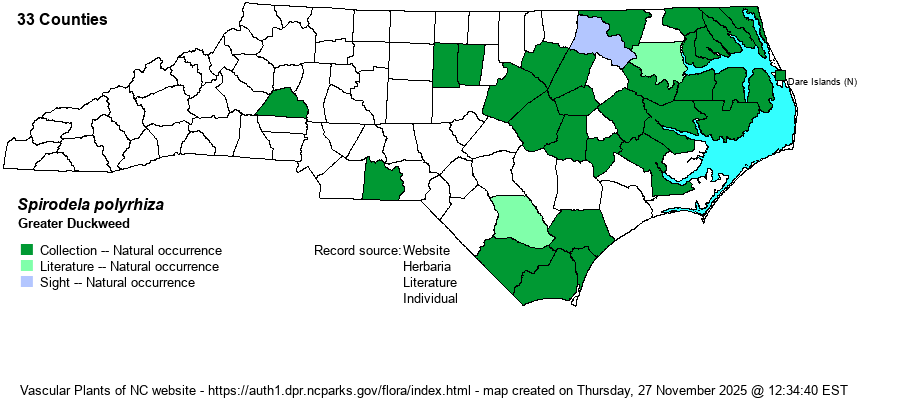| Author | (L.) Schleiden | |
| Distribution | Nearly throughout the Coastal Plain, though scarce in the southern third of the province, and absent from the Sandhills region. Ranges barely into the northeastern Piedmont, and casual into the western Piedmont (Catawba County).
This is a wide-ranging species, across most of Canada and the U.S., found in all states. However, it is scarce in the Appalachians and most of the Piedmont. | |
| Abundance | Reasonably common to common in the northern half of the Coastal Plain, south to Johnston and Craven counties. Rare to uncommon in the southeastern Coastal Plain, but absent in the southwestern portions. Very rare to rare in the northeastern Piedmont, and perhaps historical in the western Piedmont. | |
| Habitat | This species has the same habitats as other duckweeds (Lemna spp.) -- still or slowly moving waters of pools, ponds, lakes, beaver ponds, and swamps. |
| Phenology | Seemingly does not flower, or seldom does so. | |
| Identification | This is a tiny floating plant with flattened stems (fronds), rounded from above. In this genus, there are 7-21 roots per frond (on the underside of each frond); Lemna species have just a single root on each frond. This species has a fairly thick frond, as well, and is purplish below. Note that the former S. oligorrhiza, now named as Landoltia punctata, is an exotic species but is found at a number of Coastal Plain ponds and pools; it has fronds with 2-7 roots and each frond is elliptical (1.5-3 times as long as wide), whereas S. polyrrhiza has 7-21 roots per frond and has a rounded frond less than 1.5 times as long as wide. | |
| Taxonomic Comments | Some references have spelled the name as polyrrhiza.
| |
| Other Common Name(s) | Great Duckweed, Duckmeat, Great Duckmeat, Common Duckmeat | |
| State Rank | S4 | |
| Global Rank | G5 | |
| State Status | | |
| US Status | | |
| USACE-agcp | OBL link |
| USACE-emp | OBL link |

